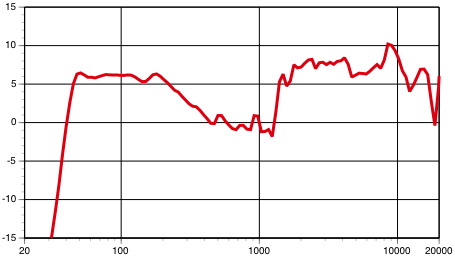Review: JBL Studio 180 tower speaker Page 4

TEST BENCH
Frequency response (at 2 meters)?
39 Hz to 20 kHz ±6.0 dB
Sensitivity (SPL at 1 meter with 2.8 volts of pink-noise input)
88 dB
Impedance (minimum/nominal)
4.3/9 ohms
Bass output (CEA-2010 standard)
• Ultra-low bass (20-31.5 Hz): NA?
• Low bass (40-63 Hz): 110.8 dB
I measured the Studio 180 at a distance of 2 meters, in order to incorporate the effects of cabinet diffraction. This gave quasi-anechoic results down to about 300 Hz. The tower speaker stood atop my measurement turntable, about 2 inches off the ground. The curves in the graph show an averaged response from 0° to 30°, smoothed to 1/12th of an octave. To get the bass response, I close-miked the woofer and port and scaled and summed the results. I then spliced the bass responses to the averaged quasi-anechoic responses to produce the curve you see here.
The Studio 180’s frequency response measurements are fairly flat except for one flaw: There’s a narrow, deep dip of about 6 dB centered at 1.1 kHz. Because this dip is so narrow, it should be barely audible. However, with our measurement technique, which incorporates reflections from the floor, this narrow dip blends in with what seems to be a floor bounce cancellation effect down to about 600 Hz, a common effect with floorstanding speakers. This is all a long-winded way of saying this speaker sounds a lot better than it might seem from these measurements. Off-axis response is superb, showing negligible response changes from directly on-axis to 30° off-axis, and only a slight deepening of the dip at 1.1 kHz at 45° and 60° off-axis.
Impedance and sensitivity of the Studio 180 are pretty much textbook. Minimum impedance is 4.3 ohms at 15 kHz, +5 degrees; it runs above 8 ohms from 20 to 95 Hz and from 325 Hz to 5.2 kHz (i.e., through about 6 octaves of its range). Impedance phase shift runs within ±30 degrees except in the low bass, where it maxes out at +57 degrees at 28 Hz. Sensitivity measures 88 dB, so the Studio 180 will deliver plenty of volume from even a low-powered receiver.
Measured as a subwoofer using CEA-2010 methodology (with a mic placed on the ground at 1 meter), the Studio 180 delivers really good average low bass (40-63 Hz) output of 110.8 dB. It actually delivers usable output (89.4 dB) at 31.5 Hz, but no measurable output below that. —B.B.













































